
The Commonwealth Building is a 14-story commercial office tower in Portland, Oregon, United States. Located at 421 SW 6th Avenue between Washington and Harvey Milk Streets, it was designed by architect Pietro Belluschi and built between 1944 and 1948. The building was originally known as the Equitable Building and is noted as one of the first glass box towers ever built, pioneering many modern features and predating the more famous Lever House in Manhattan.

The Pioneer Courthouse is a federal courthouse in Portland, Oregon, United States. Built beginning in 1869, the structure is the oldest federal building in the Pacific Northwest, and the second-oldest west of the Mississippi River. Along with Pioneer Courthouse Square, it serves as the center of downtown Portland. It is also known as the Pioneer Post Office because a popular downtown Portland post office was, until 2005, located inside. The courthouse is one of four primary locations where the United States Court of Appeals for the Ninth Circuit hears oral arguments. It also houses the chambers of the Portland-based judges on the Ninth Circuit.

Albert Ernest Doyle was a prolific architect in the U.S. states of Oregon and Washington. He is most often credited for his works as A.E. Doyle. He opened his own architectural practice in 1907. From 1908 to 1914, he partnered with William B. Patterson, and their firm was known as Doyle & Patterson.
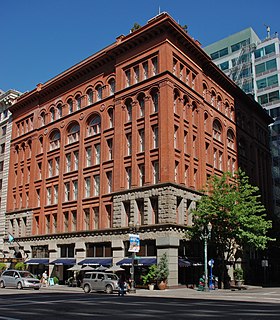
The Kimpton Hotel Vintage Portland, historically known as the Imperial Hotel and also as The Plaza Hotel, is a historic hotel building in downtown Portland, Oregon, United States. It was completed in 1894 and was listed on the National Register of Historic Places in 1985 as "Imperial Hotel". Since 2015, the building has been in use as the Kimpton Hotel Vintage Portland, and prior to then it had been known as the Hotel Vintage Plaza since 1991.

The Seward Hotel, also known as the Governor Hotel, is a historic hotel building in downtown Portland, Oregon, United States, that is listed on the National Register of Historic Places (NRHP). Built in 1909, it is one of two NRHP-listed buildings that make up the Sentinel Hotel, the other being the 1923-built Elks Temple. The Seward was renamed the Governor Hotel in 1931, closed in the mid-1980s, and reopened in 1992 joined with the former Elks building, and thereafter formed the east wing of a two-building hotel.
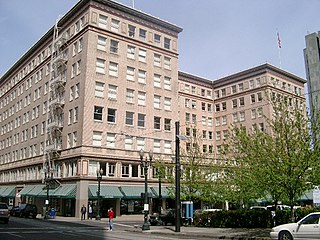
The Pittock Block is a historic building in downtown Portland, Oregon, occupying a city block between SW 9th and 10th Avenues, SW Stark and Washington Streets, and west of O'Bryant Square.

The Spalding Building, formerly the Oregon Bank Building, is a historic office building in downtown Portland, Oregon, United States on the northwest corner of SW 3rd Avenue and Washington streets. Since 1982, it has been on the National Register of Historic Places.
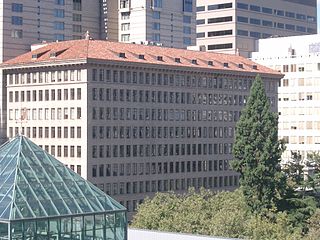
The Pacific Building is a historic office building in downtown Portland, Oregon, United States. It has been listed on the National Register of Historic Places since March 5, 1992.

The Bank of California Building, also known as the Durham & Bates Building and currently the Three Kings Building, is a historic former bank building in downtown Portland, Oregon, United States. It has been on the National Register of Historic Places since 1978. The three-story building was designed by A. E. Doyle in an Italianate style and completed in 1925. The ground floor features a two-story-high grand room with 36-foot (11 m) ceilings. The building's original owner and occupant, the Bank of California, moved out around the end of 1969 and sold the building in 1970. It has had a succession of other owners and tenants since then. It was last used as a bank in 1977.
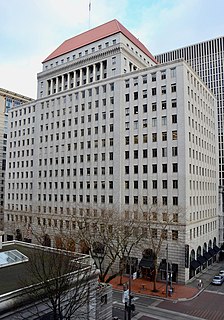
The Public Service Building is a historic 67.06 m (220.0 ft), 15-story office building in downtown Portland, Oregon, United States. The building and its attached parking garage have been listed on the National Register of Historic Places as the Public Service Building and Garage since 1996. It was built to house the offices of the Portland Gas and Coke Company and the Pacific Power and Light Company. The building's name reflects the fact that these utilities were "public services". A space in the Public Service Building fronting the corner of Salmon and Sixth streets became the first Niketown store.
Richard Wilhelm Sundeleaf was an American architect from Portland, Oregon, United States. A number of the buildings he designed are listed on the U.S. National Register of Historic Places.
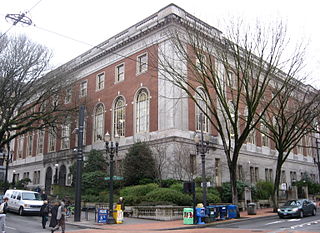
The Central Library is a three-story public library branch in downtown Portland, Oregon, United States. Opened in 1913, it serves as the main branch of the Multnomah County Library system. In 1979, the Georgian style building was added to the National Register of Historic Places as the Central Building, Public Library. The library underwent major structural and interior renovations in the mid 1990s.

The American Bank Building is a 15-floor building in Portland, Oregon, U.S. It stands 63 metres (207 ft) tall, and was built in 1913. It replaced the Marquam Building.
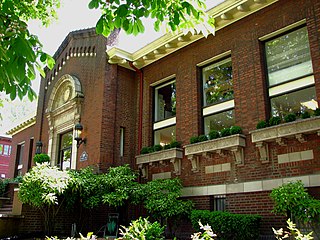
The East Portland Branch, Public Library of Multnomah County housed part of the library system of Multnomah County, Oregon, from 1911 to 1967. Designed by architect A. E. Doyle, the structure was completed in 1911 in Portland at 1110 Southeast Alder Street in the city's central eastside. Funded in part by the Carnegie Foundation, the original building consisted of one floor and a daylight basement and included reading rooms for children and adults. The building had a red brick exterior, terra-cotta trim, and a roof of green Spanish tiles. Remodeled in 1956 and remodeled again prior to its sale in 1967, the one-story building, which had rooms 18 feet (5.5 m) high, became a two-story office building.
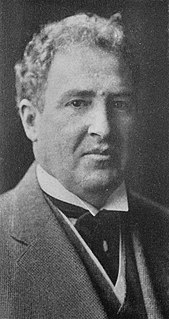
John Virginius Bennes was an American architect who designed numerous buildings throughout the state of Oregon, particularly in Baker City and Portland. In Baker City he did an extensive redesign of the Geiser Grand Hotel, designed several homes, and a now-demolished Elks building. He moved to Portland in 1907 and continued practicing there until 1942.

The Jacob Kamm House, also called the Jacob Kamm Mansion, is a French Second Empire style mansion in Portland, Oregon, built in 1871. It was moved from its original location on SW 14th and Main to its current location in Goose Hollow in 1950 to make room for Lincoln High School's campus. It was purchased by preservationist Eric Ladd for $1,000 at auction and moved to its present location, along with two other houses Ladd was interested in preserving, at SW 20th and Jefferson, which was called "the colony."

The Lipman–Wolfe and Company Building is a building located in downtown Portland, Oregon, listed on the National Register of Historic Places. It was originally the flagship store of the Lipman-Wolfe & Company department store. The architects were Doyle & Patterson.

The Selling Building, also known as the Oregon National Building, is a building located in downtown Portland, Oregon, listed on the National Register of Historic Places. It was built in 1910 for Ben Selling & Associates, composed of Ben Selling and partners Charles Moore and Moses Blum.
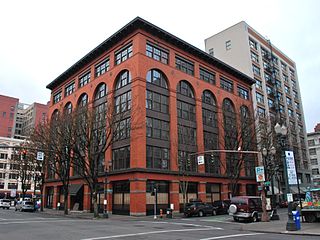
The Sherlock Building, also previously known as the Forbes and Breeden Building, is a building located in downtown Portland, Oregon, listed on the National Register of Historic Places.

The Cora Bryant Wheeler House, also known as the Mrs. Coleman H. Wheeler House, is a historic house located in Portland, Oregon, United States. Architect A. E. Doyle designed this 1923 Arts and Crafts house to take full advantage of its prominent and demanding ridgetop location. The land was purchased by Coleman and Cora in 1918 from the Frank Dekum family. The house's complex lines and massing articulating the shape of the hill, and notably including a significant amount of lumber from the Wheelers' own timberlands in the Coast Range, the Wheeler House became an important later addition to the portfolio that made Doyle one of Portland's leading architects. Junior partner Pietro Belluschi and apprentice Richard Sundeleaf, each of whom later became a significant architect in his own right, provided on-site construction supervision. The house was added to the National Register of Historic Places in 1990.
























